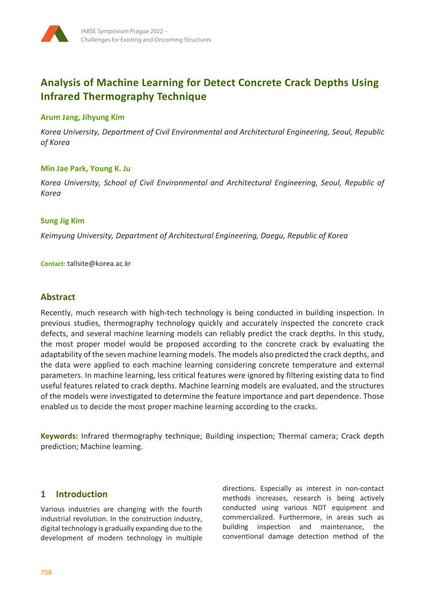Analysis of Machine Learning for Detect Concrete Crack Depths Using Infrared Thermography Technique

|
|
|||||||||||
Bibliographic Details
| Author(s): |
Arum Jang
(Korea University, Department of Civil Environmental and Architectural Engineering, Seoul, Republic of Korea)
Jihyung Kim (Korea University, Department of Civil Environmental and Architectural Engineering, Seoul, Republic of Korea) Min Jae Park (Korea University, School of Civil Environmental and Architectural Engineering, Seoul, Republic of Korea) Young K. Ju (Korea University, School of Civil Environmental and Architectural Engineering, Seoul, Republic of Korea) Sung Jig Kim (Korea University, Department of Civil Environmental and Architectural Engineering, Seoul, Republic of Korea) |
||||
|---|---|---|---|---|---|
| Medium: | conference paper | ||||
| Language(s): | English | ||||
| Conference: | IABSE Symposium: Challenges for Existing and Oncoming Structures, Prague, Czech Republic, 25-27 May 2022 | ||||
| Published in: | IABSE Symposium Prague 2022 | ||||
|
|||||
| Page(s): | 758-765 | ||||
| Total no. of pages: | 8 | ||||
| DOI: | 10.2749/prague.2022.0758 | ||||
| Abstract: |
Recently, much research with high-tech technology is being conducted in building inspection. In previous studies, thermography technology quickly and accurately inspected the concrete crack defects, and several machine learning models can reliably predict the crack depths. In this study, the most proper model would be proposed according to the concrete crack by evaluating the adaptability of the seven machine learning models. The models also predicted the crack depths, and the data were applied to each machine learning considering concrete temperature and external parameters. In machine learning, less critical features were ignored by filtering existing data to find useful features related to crack depths. Machine learning models are evaluated, and the structures of the models were investigated to determine the feature importance and part dependence. Those enabled us to decide the most proper machine learning according to the cracks. |
||||
| Keywords: |
building inspection machine learning Infrared thermography technique Thermal camera Crack depth prediction
|
||||
| Copyright: | © 2022 International Association for Bridge and Structural Engineering (IABSE) | ||||
| License: | This creative work is copyrighted material and may not be used without explicit approval by the author and/or copyright owner. |
||||
